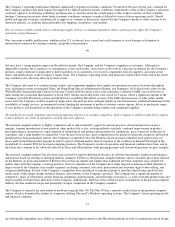Apple 2003 Annual Report Download - page 37
Download and view the complete annual report
Please find page 37 of the 2003 Apple annual report below. You can navigate through the pages in the report by either clicking on the pages listed below, or by using the keyword search tool below to find specific information within the annual report.
adversely affected.
The Company's products, from time to time, experience quality problems that can result in decreased net sales and operating profits.
The Company sells highly complex hardware and software products that can contain defects in design and manufacture. Sophisticated
operating system software and applications, such as those sold by the Company, often contain "bugs" that can unexpectedly interfere with the
operation of the software. Defects may also occur in components and products the Company purchases from third-parties that may be beyond
its control. There can be no assurance that the Company will be able to detect and fix all defects in the hardware and software it sells. Failure to
do so could result in lost revenue, loss of reputation, and significant expense to remedy.
44
The Company's retail initiative has required and will continue to require a substantial investment and commitment of resources and is subject
to numerous risks and uncertainties.
Through November 2003, the Company has opened 74 retail stores including its first international store in Tokyo, Japan. The Company's retail
initiative has required substantial investment in equipment and leasehold improvements, information systems, inventory, and personnel. The
Company has also entered into substantial operating lease commitments for retail space with lease terms ranging from 5 to 15 years. The
Company could incur substantial costs should it choose to terminate this initiative or close individual stores. Such costs could adversely affect
the Company's results of operations and financial condition. Additionally, a relatively high proportion of the Retail segment's costs are fixed
because of depreciation on store construction costs and lease expense. As a result, significant losses would result should the Retail segment
experience a decline in sales for any reason.
Certain of the Company's stores have been designed and built to serve as high profile venues that function as vehicles for general corporate
marketing, corporate events, and brand awareness. Because of their unique design elements, locations and size, these stores require
substantially more investment in equipment and leasehold improvements than the Company's more typical retail stores. The Company has
opened four such stores and has one under construction. Because of their location and size, these high profile stores also require the Company
to enter into substantially larger operating lease commitments compared to those required for its more typical stores. Current leases on such
locations have terms ranging from 10 to 15 years with total commitments per location over the lease terms ranging from $25 million to
$50 million. Closure or poor performance of one of these high profile stores could have a particularly significant negative impact on the
Company's results of operations and financial condition.
Many of the general risks and uncertainties the Company faces could also have an adverse impact on its Retail segment. Also, many factors
unique to retail operations present risks and uncertainties, some of which are beyond the Company's control, that could adversely affect the
Retail segment's future results, cause its actual results to differ from those currently expected, and/or have an adverse effect on the Company's
consolidated results of operations. Potential risks and uncertainties unique to retail operations that could have an adverse impact on the Retail
segment include, among other things, macro-economic factors that have a negative impact on general retail activity; inability to manage costs
associated with store construction and operation; lack of consumer acceptance of the Company's retail approach; failure to attract new users to
the Macintosh platform; inability to sell third-party hardware and software products at adequate margins; failure to manage relationships with
existing retail channel partners; lack of experience in managing retail operations outside the United States; costs associated with unanticipated
fluctuations in the value of Apple-branded and third-party retail inventory; and inability to obtain quality retail locations at reasonable cost.
Unit sales of the Company's professionally oriented desktop systems have declined sharply over the past several years negatively impacting net
sales and gross margin.
Unit sales of Power Macintosh systems fell 13% during 2003 as compared to 2002 and fell 18% in 2002 from 2001. Power Macintosh unit
sales have fallen as a percentage of total Macintosh unit sales from 30% in 2001 to 22% in 2003. The Company believes that weak economic
conditions over the past several years are having a pronounced negative impact on its professional and creative customers who are the primary
users of such systems. Also, it is likely that many of the Company's current and potential customers, particularly professional and creative
customers who are most likely to utilize the Company's Power Macintosh systems, believe that the relatively slower MHz rating or clock speed
of the microprocessors it utilizes in its Macintosh systems compares unfavorably to those utilized by other operating systems and translates to
slower overall system performance. In addition to the negative impact on net sales, declining sales of Power Macintosh systems also have a
negative effect on the Company's overall gross margin because Power Macintosh systems generally have higher individual gross margins than
the Company's other Macintosh systems. Continued deterioration in Power Macintosh unit sales could adversely affect the Company's future
net sales and gross margin. If future unit sales of Power Macintosh systems fail to
45
partially or fully recover, it will be difficult for the Company to improve its overall profitability. While the Company has introduced faster
Power Macintosh systems utilizing 64
-
bit PowerPC G5 processors during 2003, there can be no assurance that introduction of such systems
























